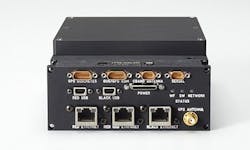Navy orders networking radios for network-centric warfare from Rockwell Collins
Officials of the Naval Air Warfare Center Weapons Division-Point Mugu at Ventura County Naval Base, Calif., are asking Rockwell Collins to provide as many as 194 Quint Networking Technology (QNT) radios.
The contract also calls for Rockwell Collins to provide 379 parts of associated hardware, as well as 36,482 hours of incidental equipment modification services for the AN/ALQ-231(V) Intrepid Tiger Electronic Attack System in support of the Joint Electronic Attack Compatibility Office.
The QNT program, supervised by the U.S. Defense Advanced Research Projects Agency (DARPA) in Arlington, Va., is developing a modular network data link to establish multiband communications among manned aircraft, unmanned combat air vehicles (UCAVs), weapons, tactical unmanned aerial vehicles (UAVs), and infantry ground forces.
QNT technology seeks to use data links to integrate tactical UAVs, infantrymen, and weapons into the future digital battlefield for network-centric warfare operations that use distributed sensor platforms to find, fix, track, and engage important stationary and moving targets in real time.
Tactical QNT focuses on providing improved tactical edge connectivity to provide warfighters with on-demand access to tactical data such as sensor video and still images.
QNT systems users are weapons, air control forces on the ground, and tactical UAVs. These three are the focal points of the QNT effort with the other two elements using hardware and waveforms from established programs.
On this contract Rockwell Collins will do the work in Cedar Rapids, Iowa, and Yuma, Ariz., and should be finished by May 2021. For more information contact Rockwell Collins online at www.rockwellcollins.com, or the Naval Air Warfare Center Weapons Division-Point Mugu at www.navair.navy.mil.
